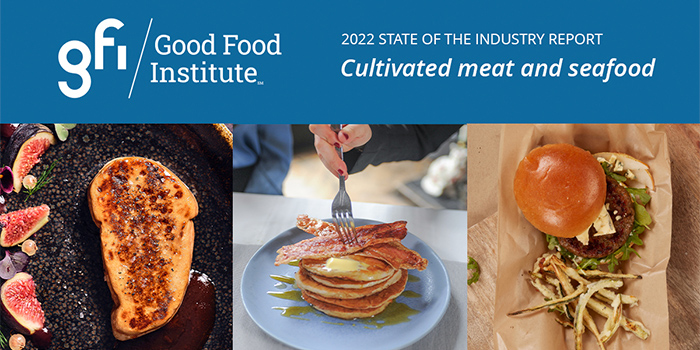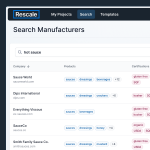GFI: Cultivated Meat and Seafood Won’t ‘Clear’ Scalability Hurdle Within The Next Decade

The cultivated meat and seafood space continued to cash large checks and garner new investor support in 2022. However, as regulatory powers in the U.S. pushed the industry closer to commercialization, discussions surrounding future challenges to scale, like price parity and consumer adoption, continue to generate uncertain expectations for growth.
“[The scalability hurdle] is not going to be cleared this decade because this is a huge thing we’re talking about – making cultivated meat at prices and scales that match conventional meat,” stated Claire Bomkamp, lead scientist for cultivated meat & seafood at The Good Food Institute (GFI), during Q&A on a webinar this week. “I do think that we will see substantial progress… [but] this is a big challenge and it’s going to take time to really get to the costs and scale that we’re looking for.”
According to GFI’s recently released The State of The Industry Report 2022: Cultivated Meat and Seafood, companies operating in this space raised a combined total of $896 million during the year. Investment decelerated 33% year-over-year in cultivated proteins, but, compared to the 35% slowdown in overall global venture funding and 46% decline in fintech investments, GFI analysts do not believe this signals a challenge for the cell-grown protein sector.
The total number of companies in the space rose to 156 and, as more and more startups emerge out of stealth mode this year, GFI expects that the category’s total investment dollars for 2022 to retroactively increase. The past year also saw the U.S. Food and Drug Administration (FDA) grant the first regulatory premarket approval for cultivated meat to Upside Foods. That event began to mitigate some of the risk associated with the space from investors’ perspectives, according to the report, which forecasts an increase in regulatory approvals this year as well as an uptick in investment.
Though deal flow stagnated, large CPG conglomerates continue to support the space. Notably JBS, which shuttered its plant-based meat arm Planterra last year, acquired cultivated protein player BioTech Foods for $39 million in May 2022. “It demonstrated that conventional meat companies are actively interested in the ultimate meat sector –continued engagement from the world’s largest companies is a positive sign for the industry’s ability to quickly scale,” said Daniel Gertner, a business analyst at GFI, during a webinar presentation.
Research from the life science industry has also become integral to continued advancement of technology as well as product innovation. Cell line research this year saw promising results from fish-derived sources and the use of methylcellulose as a stabilizer, a common ingredient in plant-based applications, was found to be a viable mode to reduce input costs, the report claims.
“I think the most significant drivers of progress, on the academic side, have been the establishment of cell lines, like immortalized bovine satellite cells, and published serum-free media formulations,” said Michael Saad, a PhD candidate focused on cultivated meat research, cited in the report. “The biggest bottleneck will be developing cost-efficient ways to study how to scale bioprocesses.”
Government investment in cultivated meat research and development, as well as other areas along the industry’s supply chain, reached new heights in 2022, including a nearly $6 million appropriation for alternative protein research to the U.S. Department of Agriculture (USDA)’s Agricultural Research Service.
GFI expects that in the near term, hybrid products – those made from both plant-based and cell-cultured proteins – will allow companies to lower costs and improve manufacturing, but as the space matures the B2B ecosystem will develop and smaller companies will likely be acquired for their technology, facilities and processing capabilities.
But with that maturation and growth, questions still remain around whether or not consumers will buy in.
‘Cultivated’ as a term was found to resonate best with consumers, according to the report, beating out ‘cell-cultured.’ However, when asked if they knew what cultivated meat was, a high percentage (ranging somewhere from 38 to 64 percent) said they were “not at all familiar” with the concept, the report states. According to GFI, this uncharted terrain leaves “huge opportunities” for consumer education and exposure.
Neither the FDA nor USDA has published labeling guidance or standardized the nomenclature around these products and in the meantime said they will jointly review labeling on a case-by-case basis.
GFI, in partnership with FAIRR, also released an Environmental Social Governance (ESG) framework for alt-protein companies this year intending to enable accurate “disclosures of the climate, water and land use, biodiversity, labor, and food security impacts of companies and their products.” Cultivated proteins are increasingly being viewed as an ESG-aligned sector, said GFI, which believes that by 2025, one-third of global assets will be managed according to ESG principles.
“More public and private investment in alternative proteins can help this nascent sector become another powerhouse for global impact and impact often starts with measurement,” said Gertner during the webinar while describing GFI’s frameworks. “These frameworks also help investors transparently understand the impacts of their investments. The investment gap between alt-proteins and other climate tech is large but it also indicates a massive runway for growth.”



















